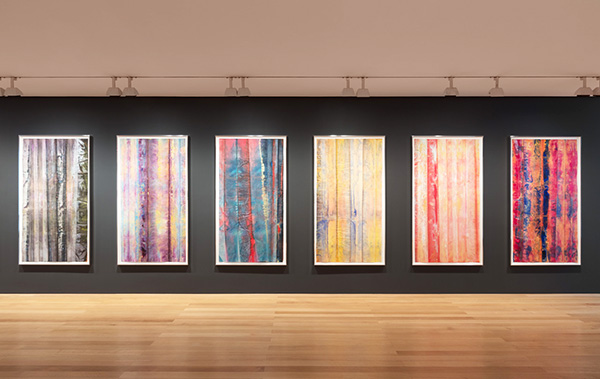샘 길리엄 종이작업@플래그아트재단(6/6-8/16)
Sam Gilliam: New Works on Paper
JUNE 6 - AUGUST 16, 2019
FLAG Art Foundation, NY

Installation view of Sam Gilliam: New Works on Paper at The FLAG Art Foundation, 2019. Photo: Steven Probert.
The FLAG Art Foundation is pleased to present Sam Gilliam: New Works on Paper, on view June 6-August 16, 2019, on its 10th floor. Created in 2019 and exhibited for the first time at FLAG, these twelve large-scale works extend Gilliam’s process-based approach to abstract painting, soaking vibrant watercolor and acrylic paints along the folds and creases of Washi[1]paper.
Gilliam, now 85, is recognized as a leading figure of the third wave of Color Field painting, which he helped revolutionize. In the late 1960s, the artist began pushing the physicality of his materials by folding, bunching, and crumpling paper and canvas, breaking with his fellow Washington color School peers who espoused the primacy of flatness and opticality. This formal inventiveness would soon result in the Gilliam’s signature “beveled-edge” and “drape” paintings, the latter of which utilized stretcher-less lengths of lush, color-saturated canvas suspended from walls and/or ceilings. For an African American artist in the nation’s capital at the height of the Civil Rights Movement, this was not merely an aesthetic proposition; it was a way of defining art’s role in a society undergoing dramatic change.
In his new suite of work, Gilliam creates compositions that mirror each other rhythmically over structuring creases. The paper’s flattened surface contains the illusion of corrugation or pleats, which, coupled with dark and light tones, create a sense of atmospheric depth. Flowing from interactions both by choice and by chance, radiant colors bleed together and overlap in an improvisatory manner that relates to the artist’s love of jazz—a purely American medium whose both controlled and free-form structure allows for variation and interpretation. Gilliam has stated that his work evokes “the drama of music and the drama of colors coming together.”
This August, Dia:Beacon will exhibit Gilliam’s large-scale Drape work Carousel II, 1969, alongside a selection of the artist’s draped paintings and one of his Beveled-Edge paintings. The exhibition at Dia is organized by outgoing chief curator Courtney J. Martin, and will be on long-term view from August 10, 2019.
Join the conversation online and follow FLAG’s Instagram (@flagartfoundation) and Twitter (@FLAGartNYC) and use the #SamGilliam hashtag when posting.
Sam Gilliam (b. 1933, Tupelo, MS) is an artist living and working in Washington, D.C. Gilliam was the subject of a solo survey exhibition at Kunstmuseum Basel, Switzerland, in 2018, and in the summer of 2019, a semi-permanent installation of his work will open at Dia:Beacon. In addition to a traveling retrospective organized by the Corcoran Gallery of Art, Washington, D.C., in 2005, he has also presented solo shows at the Phillips Collection, Washington, D.C. (2011); J.B. Speed Memorial Museum, Louisville, KY (1996); the Whitney Museum of American Art, Philip Morris Branch, New York (1993); the Studio Museum in Harlem, New York (1982); and the Museum of Modern Art, New York (1971), among many other institutions. Current and recent group exhibitions include Soul of a Nation: Art in the Age of Black Power 1963-1983, Tate Modern (2017), which traveled to the Crystal Bridges Museum of American Art, Bentonville, Arkansas (2018), Brooklyn Museum (2018), and is currently on view at The Broad, Los Angeles through September 2019; Viva Arte Viva, 57th Venice Biennale (2017); Not New Now, Marrakech Biennale 6, Morocco (2016); Black: Color, Material, Concept, Studio Museum in Harlem, New York (2015); Witness: Art and Civil Rights in the Sixties, Brooklyn Museum, New York (2014). Gilliam’s work is included in over fifty public collections, including those of the Louisiana Museum of Modern Art, Humlebaek, Denmark; Tate Modern, London; the Museum of Modern Art, New York; the Metropolitan Museum of Art, New York; and the Art Institute of Chicago.
Footnote: [1] Washi (和紙), a traditional Japanese paper, comes from the word wa meaning ‘Japanese’ and shi meaning ‘paper’. Washi is made using fibers from the inner bark of he gampi tree, the mitsumata shrub (Edgeworthia chrysantha), or the paper mulberry (kōzo) bush.





